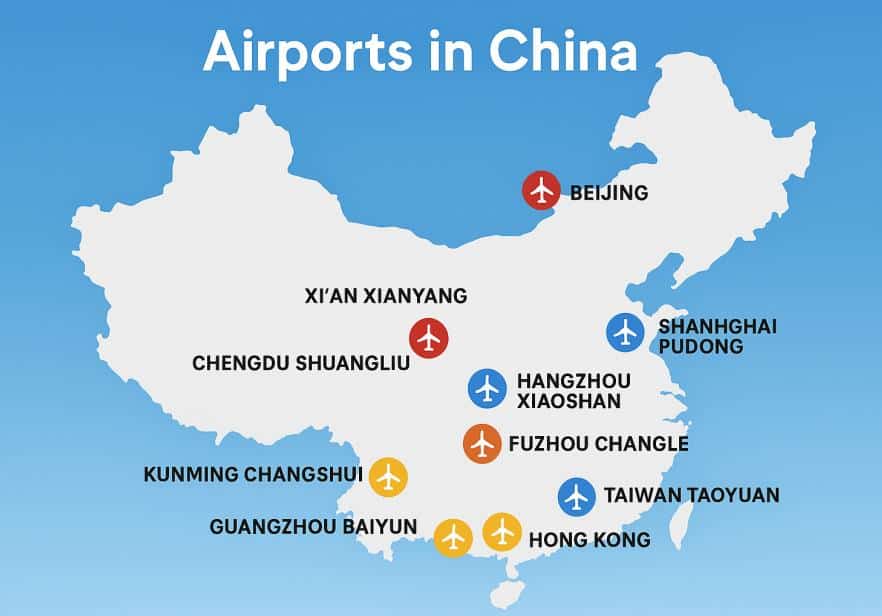Why China’s Airports Matter for Global Air Freight
As one of the largest manufacturing powerhouses in the world, China relies heavily on its expansive airport network to support exports across continents. Whether you’re shipping smartphones to Europe, textiles to Africa, or e-commerce parcels to the U.S., choosing the right China international airport can significantly impact your speed, cost, and customs experience.
China is home to some of the major airports in Asia and ranks multiple hubs on the world list of cargo airports. From high-volume infrastructure like Shanghai Pudong (PVG) to specialist e-commerce centers such as Hangzhou Xiaoshan (HGH), each air cargo gateway has unique advantages.
This 2025 guide explores:
The most efficient air cargo hubs in China
A breakdown of IATA and ICAO airport codes
How to choose the right airport for your export business
Profiles of the top 10 air freight airports in China
Whether you’re a global exporter or new to international logistics, this guide will help you navigate China’s complex but powerful air freight network.

What Makes an Airport Ideal for Air Freight Shipping?
Not all airports are created equal—especially when it comes to air freight shipping. While China has over 240 civilian airports in operation, only a handful are designed to support large-scale international exports. The most efficient airports of China for cargo logistics combine volume, connectivity, and specialized infrastructure.
Key Factors That Define a Strong Air Freight Airport
High Cargo Throughput Capacity
A leading air cargo hub must be equipped to handle millions of tons of freight annually. Advanced warehousing, automated sorting, and temperature-controlled zones are critical for supporting global trade.
International Connectivity
The best airports offer direct cargo routes to major global regions including Europe, North America, Southeast Asia, and the Middle East. Frequent outbound flights reduce transit times and minimize delays.
Customs & Bonded Area Efficiency
Smooth and fast customs clearance is essential for exporters. Key Chinese airports provide bonded logistics zones, in-transit warehouses, and integrated customs filing systems to streamline border procedures.
Ground Logistics & Multimodal Access
Airports with seamless access to expressways, seaports, and industrial zones improve supply chain coordination and reduce costs. Many of the biggest airports in China also offer rail-air or sea-air freight consolidation.
Code Recognition & Global Status
Airports with well-known IATA codes and global rankings are easier to work with in freight systems. For instance, PVG, CAN, and HKG are not only part of the airport codes in China, but also frequently listed in the world list of cargo airports.
By understanding these key features, exporters can better evaluate which international air freight hub in China is best suited for their business needs.
Top 10 Airports in China for Air Freight Shipping (with Codes & Cargo Stats)
China’s air cargo network is anchored by several major airports, many of which are recognized on the world list of cargo airports for their volume, efficiency, and global reach. These hubs serve as vital export gateways for thousands of international businesses.
Below is a list of the top 10 air freight airports in China, including their IATA/ICAO codes, locations, and notable logistics features.
Table: Top Air Cargo Airports in China (2025)
| Rank | Airport Name | IATA Code | ICAO Code | Location | Key Freight Features |
|---|---|---|---|---|---|
| 1 | Shanghai Pudong Intl. | PVG | ZSPD | Shanghai | Largest in China, global gateway, bonded zone |
| 2 | Guangzhou Baiyun Intl. | CAN | ZGGG | Guangzhou | DHL/FedEx hub, ideal for Southeast Asia exports |
| 3 | Beijing Capital Intl. | PEK | ZBAA | Beijing | Northern hub, pharma & aerospace focused |
| 4 | Shenzhen Bao’an Intl. | SZX | ZGSZ | Shenzhen | E-commerce & electronics specialist |
| 5 | Hong Kong Intl. | HKG | VHHH | Hong Kong | #1 global cargo airport, free port & tax benefits |
| 6 | Zhengzhou Xinzheng Intl. | CGO | ZHCC | Zhengzhou | Foxconn base, tech & consumer goods |
| 7 | Hangzhou Xiaoshan Intl. | HGH | ZSHC | Hangzhou | Alibaba Cainiao cross-border e-com gateway |
| 8 | Chengdu Shuangliu Intl. | CTU | ZUUU | Chengdu | Western China export hub, emerging volume |
| 9 | Xi’an Xianyang Intl. | XIY | ZLXY | Xi’an | Silk Road logistics corridor, rail-air synergy |
| 10 | Qingdao Jiaodong Intl. | TAO | ZSQD | Qingdao | Dual access to sea-air, chemicals & heavy freight |
Notes on Codes:
PEK is the 3-letter airport code for Beijing.
CAN refers to Guangzhou Baiyun International—widely searched as “airport code CAN China”.
HKG is the official Hong Kong China airport code, consistently #1 for global cargo volume.
These China airport codes are critical in freight booking systems, AWBs, customs documents, and airline tracking.

Airport Profiles – Inside China’s Top Air Freight Hubs
Understanding the strengths of each air cargo hub can help exporters select the most cost-effective and time-efficient route. Below is a closer look at five of the most strategic China export airports for international logistics.
Shanghai Pudong International Airport (PVG / ZSPD)
Location: Shanghai, East China
Best For: Electronics, machinery, pharmaceuticals
Connectivity: Over 80 cargo airlines, direct routes to Europe, US, and Southeast Asia
Facilities: Multiple bonded warehouses, cold chain systems, and 24/7 customs support
Why it stands out: PVG consistently ranks in the world list of cargo airports. As the busiest international shipping airport in mainland China, it’s ideal for high-volume and time-sensitive exports.
Guangzhou Baiyun International Airport (CAN / ZGGG)
Location: Guangdong Province, South China
Best For: Garments, e-commerce, electronics
Advantages: Proximity to Shenzhen, Dongguan, Foshan production zones
Customs: Rapid clearance via integrated freight terminals
CAN, also known by its airport code CAN China, is a major China export airport and regional hub for DHL and FedEx.
Beijing Capital International Airport (PEK / ZBAA)
Location: Beijing, North China
Best For: Pharmaceuticals, aerospace, government-related cargo
Connectivity: Frequent flights to Europe and Russia
Facilities: Smart customs inspection and temperature-sensitive storage
As the national capital’s leading airport, PEK is a preferred hub for sensitive or regulated exports. It’s globally recognized under the 3 letter airport code for Beijing.
Shenzhen Bao’an International Airport (SZX / ZGSZ)
Location: Shenzhen, South China
Best For: Mobile phones, semiconductors, Amazon FBA, small parcels
E-com Integration: Close to fulfillment centers and freight consolidators
Access: Connects to Hong Kong, CAN, and dozens of regional trade hubs
SZX is one of the fastest-growing air cargo hubs in China, especially strong in cross-border e-commerce exports.
Hong Kong International Airport (HKG / VHHH)
Location: Hong Kong SAR
Best For: High-value, express, and global transit cargo
Strengths: Tax advantages, efficient customs, and sea-air options
Cross-Border: Linked by truck to Shenzhen and the Pearl River Delta factories
HKG, the official Hong Kong China airport code, is the world’s #1 cargo airport by volume. It’s often used as a consolidation and redistribution point for high-frequency international routes.
Understanding China Airport Codes – IATA vs ICAO Explained
When managing air freight from China, it’s crucial to understand the airport codes in China, which are standardized under two systems: IATA and ICAO. These codes are essential for booking shipments, customs clearance, and tracking cargo through airline and freight systems.
What is an IATA Airport Code?
IATA codes are the 3-letter airport identifiers used by airlines, freight forwarders, and booking systems.
Found on: Air waybills (AWBs), labels, commercial invoices, and logistics documents.
Examples:
PVG – Shanghai Pudong International
PEK – 3 letter airport code for Beijing Capital
CAN – Guangzhou Baiyun
HKG – Hong Kong International
IATA codes are the most visible and frequently used in international freight logistics.
What is an ICAO Airport Code?
ICAO codes are 4-letter airport identifiers used in flight operations, customs filings, and air traffic control.
🇨🇳 For China, ICAO codes typically begin with “Z”, and for Hong Kong, they begin with “VH”.
Examples:
| Airport | IATA Code | ICAO Code |
|---|---|---|
| Beijing Capital | PEK | ZBAA |
| Guangzhou Baiyun | CAN | ZGGG |
| Shanghai Pudong | PVG | ZSPD |
| Shenzhen Bao’an | SZX | ZGSZ |
| Hong Kong Intl. | HKG | VHHH |
ICAO codes are especially important for freight customs declaration and aviation planning.
Summary: How to Use Airport Codes for Exports
| Use Case | Recommended Code Type |
|---|---|
| Booking cargo flights | IATA code (e.g. PVG) |
| Freight labels and AWBs | IATA code |
| Customs documents and CIQ filing | ICAO code (e.g. ZSPD) |
| Aviation system integration | ICAO code |
Understanding both codes helps exporters avoid shipping delays, documentation errors, and misrouted cargo.

How to Choose the Best Airport for Your Air Freight Export from China
Choosing the right airport can significantly affect your shipping cost, transit time, and customs efficiency. With so many options across China, the decision isn’t just about proximity—it’s about matching the airport’s strengths with your cargo needs.
Here’s a framework to help exporters and logistics managers choose the best cargo airport in China:
Match Airport Type with Your Product
| Product Type | Recommended Airports |
|---|---|
| Electronics & tech | Shenzhen (SZX), Zhengzhou (CGO), Hangzhou (HGH) |
| E-commerce parcels | Hangzhou (HGH), Hong Kong (HKG), Guangzhou (CAN) |
| Medical & pharma | Beijing (PEK), Shanghai (PVG) |
| General consumer goods | Guangzhou (CAN), Shanghai (PVG), Qingdao (TAO) |
| Urgent or express cargo | HKG, PEK, SZX |
Consider Your Destination Country
Select an international air freight hub with direct or high-frequency flights to your buyer’s location:
North America: PVG, CAN, HKG, PEK
Europe: PVG, PEK, HKG, CTU
Middle East & Africa: PEK, PVG, HKG
Southeast Asia & Australia: CAN, SZX, HGH
Check Ground Logistics & Multimodal Access
Look for airports with:
Bonded warehouses and customs inspection zones
Trucking access to factories or ports (e.g. in Shenzhen or Qingdao)
Proximity to rail-air or sea-air integration points
For example, Qingdao (TAO) offers strong sea-air synergies, while Zhengzhou (CGO) links well with the China-Europe Railway Express.
Consult a Freight Forwarder Familiar with the Route
An experienced China-based freight forwarder will help you:
Compare flight frequencies and costs across airports
Recommend seasonal rate strategies (avoid peak congestion)
Consolidate goods from multiple suppliers for better pricing
Arrange DDP or customs-cleared delivery at destination
Summary Checklist
Before booking your shipment, ask:
Does the airport specialize in my type of cargo?
Are there direct or frequent flights to my buyer’s region?
Will it reduce my cost per kg or improve customs clearance?
Is it integrated with ground transport or fulfillment hubs?
Choosing the right airport is just as critical as choosing the right shipping method—it’s where your logistics strategy begins.
Working with Freight Forwarders – Bringing Your Air Export Strategy Together
Understanding China’s top cargo airports is only part of a successful export strategy. To fully leverage these gateways, exporters should work with a reliable air freight forwarder in China—a partner who can coordinate flights, handle customs, and manage last-mile delivery.
A professional China air freight agent offers more than just booking space on planes. The best air freight companies in China provide:
Route selection based on real-time airline capacity
Air cargo services in China tailored to specific goods (e.g. electronics, pharma)
Consolidation for multi-supplier shipments
Full documentation & customs support for international air freight from China
Whether you’re shipping from Guangzhou (CAN), Shanghai (PVG), or Shenzhen (SZX), a seasoned freight agent can simplify the China air shipping process and help reduce risk.
Many agents also offer door-to-door air cargo from China, which includes export pickup, customs clearance, and last-mile delivery abroad—ideal for e-commerce sellers and urgent deliveries.

FAQs About China Airports and Air Freight Logistics
What is the most commonly used China airport code for exports?
The most frequently used China airport codes include:
PVG – Shanghai Pudong
CAN – Guangzhou Baiyun (airport code CAN China)
PEK – Beijing Capital
HKG – Hong Kong International
SZX – Shenzhen Bao’an
These airports handle a majority of China’s outbound cargo and are well-integrated with freight booking and customs systems.
Which airport in China is best for urgent international deliveries?
For fast, high-frequency global exports, the best options are:
Hong Kong International (HKG)
Beijing Capital (PEK)
Shanghai Pudong (PVG)
These are full-service air cargo hubs with efficient customs processes, express cargo capacity, and direct flights to Europe and North America.
What is the biggest airport in China by cargo volume?
As of 2025, Shanghai Pudong (PVG) is the biggest airport in China for international freight volume.
It is followed closely by Guangzhou (CAN) and Hong Kong (HKG), both ranked in the world list of cargo airports.
Are there differences between airports for e-commerce and traditional freight?
Yes. Airports like Hangzhou (HGH) and Shenzhen (SZX) are optimized for small parcel processing, bonded warehouse integration, and customs automation—ideal for e-commerce.
Meanwhile, airports like PVG and CAN are better suited for high-volume bulk freight and industrial goods.
How do I choose between two nearby airports?
Consider:
Cargo type and required handling (e.g. perishable, DG, bonded)
Destination flight availability
Ground trucking cost differences
Customs clearance efficiency
A knowledgeable forwarder can help you choose the best cargo airport based on shipment value, size, and timing.
Conclusion – Choosing the Right Airport for Export Success
Navigating China’s air freight network may seem complex, but with the right strategy, it becomes a powerful asset in your global supply chain. Whether you’re exporting electronics, apparel, pharmaceuticals, or e-commerce parcels, choosing the best airport for air freight in China can save time, reduce risk, and optimize cost.
From the efficiency of Shanghai Pudong (PVG) to the flexibility of Guangzhou (CAN) and the global reach of Hong Kong (HKG), each air cargo hub offers distinct advantages. The key is to align your cargo type, destination, and delivery timeline with the airport’s strengths.
Understanding and using the correct China airport codes—whether IATA or ICAO—ensures smooth documentation, accurate booking, and fast customs clearance. And partnering with an experienced freight logistics provider in China helps simplify complex routing decisions and access better shipping rates.
Final Exporter Tips:
Always evaluate airport performance—not just location.
Know your product’s special handling needs.
Use major international shipping airports with global airline networks.
Stay informed on peak seasons, rate fluctuations, and customs policies.
Work with a freight forwarder who understands both airport infrastructure and China export logistics.
Ready to streamline your air freight exports from China?
Contact us for tailored solutions from the top air freight hubs in China—from pickup to final delivery, backed by accurate routing and competitive pricing.


